Abstract
In this research work, the photocatalytic capacity shown by the nanoparticles of the CaTiO3 system was evaluated to degrade two pollutants of emerging concern, namely methyl orange (MO)—considered an organic contaminating substance of the textile industry that is non-biodegradable when dissolved in water—and levofloxacin (LVF), an antibiotic widely used in the treatment of infectious diseases that is released mostly to the environment in its original chemical form. The synthesis process used to obtain these powders was the polymeric precursor method (Pechini), at a temperature of 700 °C for 6 h. The characterization of the obtained oxide nanoparticles of interest revealed the presence of a majority perovskite-type phase with an orthorhombic structure and a minority rutile-type phase, with a structure and a primary particle size . The adsorption–desorption isotherms of the synthesized solids had H3-type hysteresis loops, characteristic of mesoporous solids, with a BET surface area of . The Raman and FTIR spectroscopy results made it possible to identify the characteristic vibrations of the synthesized system and the characteristic deformations of the perovskite structure, reiterating the results obtained from the XRD analysis. Furthermore, a bandgap energy of and characteristic emissions in the violet (437 nm/2.8 eV) and orange (611 nm/2.03 eV) were determined for excitation lengths of 250 nm and 325 nm, respectively, showing that these systems have a strong emission in the visible light region and allowing their use in photocatalytic activity to be potentialized. The powders obtained were studied for their photocatalytic capacity to degrade methyl orange (MO) and levofloxacin (LVF), dissolved in water. To quantify the coloring concentration, UV–visible spectroscopy was used considering the variation in the intensity of the characteristic of the greatest absorption, which correlated with the change in the concentration of the contaminant in the solution. The results showed that after irradiation with ultraviolet light, the degradation of the contaminants MO and LVF was 79.4% and 98.1% with concentrations of 5 g/L and 10 g/L, respectively.
1. Introduction
Emerging pollutants (EPs) are synthetic or naturally occurring chemicals or biological pollutants whose presence in the environment is not considered significant in terms of distribution and concentration, so they tend not to be monitored [1,2]. There is currently a growing interest in emerging pollutants, since they cause environmental problems and risks to health. These compounds are disseminated in the environment and have been detected in water supply sources, groundwater, and even in drinking water. They are compounds of which relatively little is known, in terms of their presence, impact, and treatment. In most cases, they are unregulated contaminants, which may be candidates for future regulation, depending on research on their potential health effects and monitoring data regarding their incidence in the environment; therefore, they are very much worth researching [1]. Among the main EPs are pharmaceuticals, personal and animal care products, pesticides, flame retardants, industrial additives, food additives, lifestyle products, illicit drugs, perfluorinated compounds, hormones, microplastics, engineered nanomaterials, resistance genes, and dyes [1,3,4,5,6,7]. Nevertheless, the list is long and not definitive, because more substances emerge every day that can be included. Table 1 presents a division that is common to several studies [4].

Table 1.
Representative groups and compounds of EPs [4,8].
The main sources of EPs are domestic wastewater, hospital effluents, industrial wastewater, agricultural, livestock and aquaculture runoff, and landfill leachate, with the effluent from wastewater treatment plants being the main contributor to the occurrence of EPs in bodies of water [8]. This is mainly because wastewater treatment plants are not designed to remove this type of pollution. The discharged effluent thus contains organic substances and metabolites which may reach the environment worldwide [8]. Even when usually detected at low concentrations, from µgL−1 to ngL−1 and rarely in mgL−1, EPs are capable of causing adverse effects in organisms [9]. Their effects range from alterations in the immune system of aquatic animals to mutations and cancer in humans [4,8]. Perfluorinated compounds, personal care products, engineered nanomaterials, antibiotics, and resistance genes are considered as endocrine disruptors [7]. Despite their presence in such low quantities, they have shown various levels of ecotoxicity, cytotoxicity, and genotoxicity in the environment. Several studies have been conducted on the toxicity of emerging contaminants, and they have been found to cause both acute and chronic effects in different organisms ranging from aquatic organisms to human beings (see Table 2) [10].

Table 2.
Toxicological effects of emerging contaminants on humans and biota [10,11,12].
The presence of EPs is increasing day by day due to the inability of conventional treatments to remove them. In addition, they can accumulate in the trophic chain and migrate to groundwater sources, or be deposited in sediments [4]. Normal organic matter can be degraded easily through water purification. Eps, on the other hand, can barely be removed this way due to five features: serious harm, hidden risks, environmental persistence, wide sources, and complex governance. The efficient removal of EPs in water has thus become one of the most pressing topics for researchers [2]. Pharmaceuticals and dyes are among the contaminants that are increasingly being identified in bodies of water. They are resistant and difficult to remove in conventional wastewater treatment plants [6].
Global health problems have contributed to the expansion of the pharmaceutical industries and the consumption of medicines. The incorrect disposal of these compounds and the excretion by animals and humans of up to 90% of the administered drugs represent a threat to various environments, since their active principles are constantly found in small amounts in drinking water, wastewater, and surface water, interacting with biological systems, poisoning animals, and harming human health [13,14]. Drugs from the therapeutic classes of analgesics/nonsteroidal anti-inflammatory drugs, antibiotics, beta-blockers, and psychiatric drugs have been extensively detected worldwide at moderately high concentrations (up to hundreds of µg) [15]. Since the COVID-19 outbreak, approximately 70% of hospitalized patients have been treated with antibiotics. Levofloxacin (LVF) is an antibiotic that is widely used in the treatment of infectious diseases [16], and due to its broad-spectrum antibacterial activity, it is also used in animal husbandry and agriculture [17,18]. However, only a small part of LVF is metabolized or absorbed in the body, and most is released into the environment in its original form [16], generally due to the high stability of LVF molecules, most of which will be metabolized in the natural environment in the form of active species after being consumed, causing irreversible damage to the ecological environment [19] due to their persistence towards biodegradation [20].
Additionally, around the world, about tons of inks are produced annually. Wastewater that is contaminated with dyes from the textile, paper, pharmaceutical, and other industries is also discharged into the environment in large quantities [16]. Dyes have thus become one of the main sources of water pollution, and methyl orange (MO) is one of the most widely used organic dyes in the textile industry [21]. The discharge of large amounts of antibiotics and organic dyes causes water pollution and seriously threatens aquatic organisms and human society. Therefore, it is crucial to search for a green and efficient treatment technology for the degradation of LVF and MO [16].
Technologies of a physicochemical nature have been designed, such as membrane filtration or adsorption using activated carbon, which are expensive and commercially unattractive. Furthermore, these processes are limited to transferring contaminants from one phase to another instead of removing them [22]. Various technologies have been explored for the treatment of water contaminated with antibiotics, among which the following stand out: chemical oxidation, physical adsorption, and biodegradation [23]. Among the conventional technologies used for the treatment of waters that contain dyes are ion exchange [24], precipitation [22], chlorination [25], reverse osmosis [26], flocculation, and coagulation [27,28,29]. Such conventional treatments, used for the decontamination of water, are procedures that are inadequate to reach the degree of purity required by law or to enable the subsequent use of the treated effluent [30].
This has led to considering, as a good alternative, what are known as advanced oxidation technologies or processes (AOTs or AOPs, respectively) that are not as widely applied as they ought to be and, worse still, are not widely disseminated in emerging economies like those of Latin America. Most AOTs can be applied to the remediation and removal of contaminants from special waters, generally on a small or medium scale [30]. The methods can be used alone or in combination, among themselves or with conventional methods, and can also be applied to contaminants in air and soil, even allowing disinfection through the inactivation of bacteria and viruses [30]. AOPs are based on physicochemical processes capable of producing profound changes in the chemical structure of pollutants. They are radical-mediated oxidation processes that have the capacity for the complete mineralization of organic compounds [31].
The concept was initially established by Glaze et al. [30], who defined AOPs as processes that involve the generation and use of highly oxidizing transient species, such as the hydroxyl radical , which can be generated mainly through photochemical means (including sunlight) or using other forms of energy, and which has a high capacity to oxidize organic matter [30]. Among them, photocatalytic technology is considered the most promising method because it is economical, reusable, and ecological [16]. Photocatalysis has been widely reported for the degradation of dyes and antibiotics; several investigations have recently been published on the degradation of dyes [31,32,33,34,35,36] and on the degradation of antibiotics, specifically LVF [16,17,18,19,20].
Some inorganic semiconductor photocatalysts such as , and CdS have been developed and applied in photocatalysis. When the photocatalyst absorbs light energy, electrons and holes are generated on the surface of the material. The and can induce the redox reaction of and to generate a superoxide radical and a hydroxyl radical , which have a strong potential for the direct oxidation of organic contaminants to and or small molecule species.
However, despite great efforts in the development of efficient photocatalysts, traditional photocatalysts absorb only ultraviolet light and offer lower quantum efficiency, which limits their implementation on an industrial scale. Therefore, to overcome these limitations, the development of stable and efficient visible light photocatalysts is necessary. The design of new organic semiconductor photocatalysts offers an alternative in improving the surface area, adjusting the internal pore size and high porosity, providing additional reaction sites, which increases the photoreactivity of these materials. Photocatalytic water splitting using polymeric semiconductors to produce hydrogen has promising applications but is still in the fundamental stage at the laboratory scale [37]. Some research on polymeric materials has shown their photocatalytic efficiency in the degradation of contaminants; examples of these materials are coordination polymers (CPs) [38] and metal–organic structures (MOFs) [39]. The exploration of appropriate building blocks remains a challenge for the development of highly efficient polymeric photocatalysts, and an alternative in future work may be to expand procedures to combine photocatalysis (with organic, transition metal, and inorganic semiconductors), green chemistry, and nanotechnology [40].
Elsewhere, perovskite-type catalytic materials for heterogeneous photocatalysis are mixed metal oxides that are gaining relevance due to their structural flexibility [40], increase in surface area [41], high extinction coefficients, optimal band gaps, high photoluminescent quantum yields, and long electron–hole diffusion lengths [42]. Among numerous photocatalysts, , as a typical perovskite-type metal oxide, has shown potential application prospects in the field of photocatalysis due to its high stability and excellent photoelectric catalytic activity [16]. However, despite the important contributions of research work referring to the synthesis processes of structures of the system, the study of the synthesis conditions and their influence on the structural, optical, and physicochemical properties in these materials continue as research topics, mainly given their potential uses in the degradation of contaminants from textile wastewater [43].
Among the most explored synthesis methods to obtain CTO are hydrothermal, solvothermal, co-precipitation, chemical vapor deposition, microwave [44], solid-state reaction [45], combustion, polyacrylamide gel, microwave-assisted hydrothermal, sol–gel, and electrospinning [46]. However, the control over the purity of the material is not clear in the different synthesis processes presented, given that some parameters, such as the sintering temperature, generate small percentages of secondary phases that can modify its catalytic capacity [47]. The different synthesis routes indicate that obtaining CaTiO3 powders and their possible applications in photocatalysis depend on the methodology, precursors used, concentrations, and thermal treatment temperature. Currently, alternative methods are being sought such as reactive spark plasma sintering (SPS) and spark plasma sintering–reaction synthesis (SPS-RS), which use high-speed heating (250–300 °C/min) of nanopowders up to the sintering temperature, using short electrical pulses with moderate pressure (<100 MPa). These methods have been used to obtain systems with a perovskite structure, being promising in improving the physical–chemical characteristics, since the formation of grain boundaries and surface diffusion is favored, which can improve the catalytic properties of these materials [41,48]. Another alternative process is the polymer precursor method, which has been little used in the synthesis of perovskite structures, despite having multiple advantages in obtaining mixed valence solids. The use of this method improves the problems of segregation or precipitation in the solution of the precursors, generating control in the purity of the material, mainly due to the fixation of the cations to the resin, thus allowing a better stoichiometry of the compound that it is sought to obtain. This research proposes to synthesize powders using the modified polymeric precursor method, which has not been reported in CTO synthesis processes.
The study objective is to present the process of the synthesis and characterization of the perovskite-type ceramic powder and its capacity for the photodegradation of emerging contaminants, MO and LVF, driven by ultraviolet light.
2. Materials and Methods
2.1. Preparation of Nanoparticles using the Pechini Polymeric Precursor Method
Ethylene glycol (, purity 99.8% - Merck Millipore) was heated to a temperature of 70 °C, then citric acid (C6H8O7⋅H2O, purity 99.5%—Merck Millipore) was added in the solid phase whilst maintaining a steady temperature and stirring constantly until a clear solution was obtained. Once the mixture was homogeneous, it was brought to room temperature and titanium tetrabutoxide (]4, purity of 97.0%—Sigma Aldrich), and calcium acetate (, purity 94% - Sigma Aldrich) were slowly added.
The uniform mixture of ethylene glycol, citric acid, and the precursors of the cations of interest was brought to a suitable pH by slowly adding ammonium hydroxide ( in at 28%, purity ≥99.99% - Merck Millipore). Process control was carried out with the Hanna Instruments 2021 pH-meter, working with a glass electrode previously calibrated with the buffer solutions of pH 4, pH 7, and pH 10. The solution was subsequently heated to a moderate temperature of ~130 °C, with continuous stirring, to promote the esterification and polyesterification processes, until a transparent polymeric resin was formed. This resin was calcined between 200 and 300 °C to remove the solvent present in the system (pre-calcination process). The solid obtained from the pre-calcination was thermally treated at 700 °C, for 6 h, to remove the organic material and obtain the mixture of oxides of interest.
2.2. Potentiometric Titration Curve
The potentiometric titration curve of the solutions of the system was obtained by adding 0.5 mL of an ammonium hydroxide solution ( at 28%, purity ≥99.99% - Merck Millipore) with an Airco 160801-023 dispenser. The pH value of the systems, as well as the volume of the added base, was recorded periodically during the addition of until reaching the stabilization pH value.
2.3. Structural and Optical Characterization of Ceramic Powders
In order to determine the most appropriate heat treatment temperatures in the synthesis process, evaluate the effect of heat treatment, and consider the different physicochemical events that might occur in the pre-calcined samples of the systems, differential scanning calorimetry (DSC) and thermogravimetric analysis (TGA) curves were obtained in a temperature range of 28 to 1000 °C, using a simultaneous thermal analyzer SDT Q600 V20.9 Build 20 from TA instruments, with an alumina cell, a nominal air flow of 100 mL/min, and a heating ramp of 10 °C/min. The crystalline phases present in the synthesized ceramic powders were identified by obtaining diffractograms of the system. The FEI Inspect S 50 scanning electron microscope was used to determine the size, shape, and state of agglomeration of the particles. The equipment used was the PANalytical X’Pert PRO MRD Diffractometer with a Cu source (λ = 1.54 Å), belonging to the X-ray diffraction laboratory of the Universidad del Valle, Santiago de Cali - Colombia. The tests were carried out at a voltage of at , at a current of , in the measurement range of 20–100°.
The results obtained were processed and analyzed using the X’pert HighScore 3.0.0 and GSAS 1.0.0 programs. The specific surface area, the volume, and the pore size distribution of the synthesized porous material were obtained via adsorption with and the method, using the 3 FLEX Micromeritics equipment. All samples were degassed at 200 °C before determining the adsorption isotherms. The functional groups present in the different samples of the systems obtained during the synthesis process were determined via FTIR spectroscopy. The Jasco FTIR 6800 spectrophotometer was used to carry out the test. The FTIR spectra obtained were performed at a resolution of . For detailed analysis of the previously obtained FTIR spectra, these were analyzed by using the Fityk 0.8.6 software at using symmetrical Gaussian curves.
To perform the Raman spectroscopy analysis, a JASCO Raman analyzer, model NRS-4500, was used, using a laser excitation source with a wavelength of and an integration time of 20 s, for each spectrum, in a range between and . UV-Vis diffuse reflectance spectroscopy (UV-Vis-DRS) was used to determine the electronic transitions of solid structures when irradiated with ultraviolet or visible light. With the resulting absorption spectrum, it is possible to obtain the energy value of the bandwidth. The spectra of the synthesized powders were obtained with a JASCO V-700 UV-Vis-NIR spectrophotometer in the range between and , and at a scanning speed of . A photoluminescence (PL) study of the synthesized samples was carried out in order to obtain information on the efficiency of the charge capture, migration, and transfer processes, as well as on the surface states and the presence of defects at room temperature (RT) using a JASCO FP-8250 spectrophotometer, with a xenon discharge lamp (150 W power) as the excitation source.
2.4. Photocatalytic Evaluation of Nanoparticles
To evaluate the degradation capacity of MO and LVF by the compounds, the UV-Vis spectroscopy technique was used. Initially, the relationship between the absorbance recorded with the spectrophotometer and the concentration of pollutants in the solution were determined, obtaining the contaminant calibration curve. UV-Vis absorption spectra were obtained using a JASCO V-700 spectrophotometer in the range of . Subsequently, solutions of MO (Sigma-Aldrich) and commercial LVF (Laproff laboratories, Colombia) with initial concentrations of 10 ppm were introduced into a photodegradation chamber with magnetic stirring at and equipped with an 800 Watt Philips mercury lamp. The pH of the solution was set at 6.2 and 4.5 for the MO and LVF, respectively; the temperature of the systems was maintained at 37 °C. It was decided to study the kinetics of photodegradation using 3, 5, 10, and 15 g of catalyst for each L of MO and LVF at 10 ppm, under constant stirring and in times that varied between 15 and 180 min.
Initially, the nanoparticles were added to the solution with the contaminant. This mixture was located in the photoreactor in the absence of UV radiation and with magnetic stirring for 30 min in order to ensure the adsorption–desorption equilibrium on the catalyst surface. Once this period was completed, the reaction was started by turning on the lamp. To carry out the experiment, aliquots of the solution (~3 mL) were taken every 15 min, removing the nanoparticles by means of centrifugation at 7000× g rpm for two minutes. The degradation of the contaminants was analyzed through the decrease in intensity of the maximum absorption peak, located approximately at for MO and 293 nm for LVF.
From the spectra obtained, the absorbance values corresponding to the peaks of the maximum absorbance characteristics of MO and LVF were recorded. Using the calibration curve, the MO and LVF concentration values were obtained for each aliquot. With these concentration values, for the different times and the initial concentration of pollutants in the system, the normalized concentration curves were obtained. In addition, the percentage of removal of the contaminant from the solutions was calculated using the following expression:
where and are the initial concentration values of the pollutant and the concentration at time “t”, respectively.
3. Results and Discussions
3.1. Potentiometric Titration Curves
To ensure the reproducibility of the method and the suitable characteristics of the final product, the potentiometric titration curves were made (Figure 1), which allow for the monitoring of the synthesis process, recording the variation in a physicochemical parameter () depending on the amount of added to the system. The initial system, the solution of the precursor, had an opaque white color with a pH value between 4 and 5, such that, by adding ammonium hydroxide at a rate of , its pH increased, as illustrated in Figure 1, zone (I). In zone (II) of the process, when the pH was between 5 and 8, the system changed color, turning yellow. Finally, in zone (III), the pH stabilized until reaching a value between 8 and 8.2; in this region, the system gave an opaque yellow color.
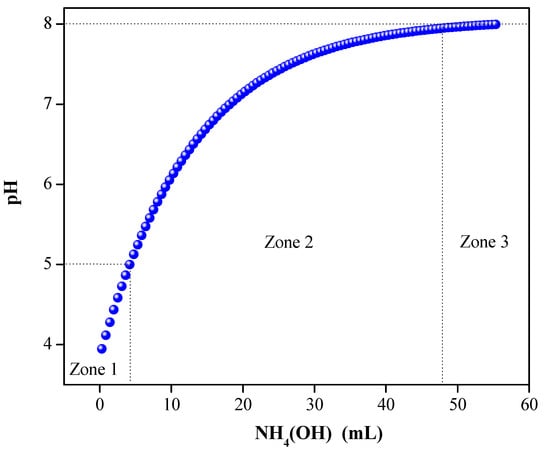
Figure 1.
Potentiometric titration curve of the system.
3.2. Characterization of the Solid Phase
3.2.1. Thermogravimetric Analysis (TGA) and Differential Scanning Calorimetry (DSC)
To establish the effect of heat treatment on the samples of the system and determine the optimal temperature for synthesis of the oxide of interest, TGA and DSC analyses were performed. Figure 2 shows the thermal evolution of the pre-calcined system obtained by using the Pechini method. The thermogravimetric curve (TGA Figure 2, black line) shows that four important physicochemical events occurred that produced mass losses in the system. These events were related to different thermal peaks that were observed in the calorimetry curve (DSC Figure 2, blue line). Thus, at a temperature of 90 °C, an endothermic peak occurred, associated with a weight loss of 6.31% up to 200 °C; this physicochemical event is related to the removal of water adsorbed on the surface of the powdered material [49,50]. Between 400 and 750 °C, three exothermic peaks were observed at ~481, 564, and 619 °C, which could be attributed to the oxidation of the organic phase present in the system, initially favoring the formation of oxy-carbonates and finally that of the oxide [49,50,51]. These exothermic peaks are assigned to mass losses of ~15, 10, and 7.8%, respectively (Figure 2). For temperatures higher than 700 °C, the weight loss of the sample was not appreciable.
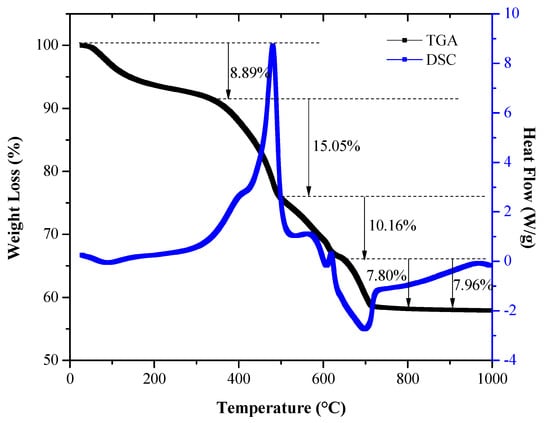
Figure 2.
Thermal analysis corresponding to the pre-calcination that was used to obtain the system.
According to the results obtained, it can be observed that the most important physicochemical processes, which lead to obtaining the oxide of interest, occur below 700 °C. Above this temperature, the weight of the sample remains almost constant, which is a sign of the completion of the reactions and the formation of the crystalline phase of the compound [51]. This led to defining this temperature to thermally treat the pre-calcinate and obtain the of interest.
3.2.2. Scanning Electron Microscope
Figure 3 shows the SEM micrographs for the powders of the systems. The micrographs show the agglomeration of the primary particles (Figure 3a), whose secondary particles have a random shape, made up of groups of disordered primary particles (Figure 3b). The size of the secondary particles (agglomerates) for these two compositions is close to 500 nm. Figure 3c shows the results of the elemental chemical analysis, performed with the EDS microprobe, in the region indicated by the box. When observing the EDS spectra of the sample, the Ca, Ti, and O were evidenced as the only elements present. Moreover, taking as a reference the theoretical percentages of each element, and considering the stoichiometry of the compound, when comparing these data with those obtained from the EDS analysis, an agreement with the calculated theoretical percentage is evident.
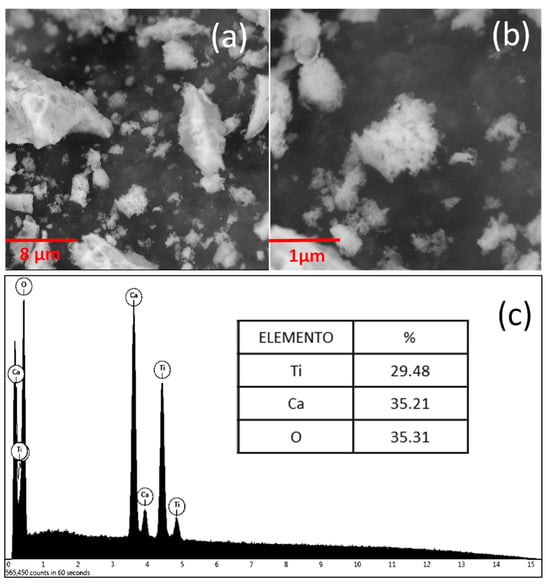
Figure 3.
SEM Micrographs: (a) ×8700, (b) ×22,500, and (c) EDS.
3.2.3. X-ray Diffraction
Figure 4 shows the XRD patterns of the system samples synthesized at 700 °C. The analysis of the X-ray diffraction patterns (XRD) was carried out using the X’pert HighScore program and using the Rietveld refinement technique with the GSAS program. The Rietveld refinement results indicated that the sample presents a majority perovskite-type phase with a orthorhombic structure and space group 62, and a minority phase of , which was rutile-type with a structure and space group 136. The diffractogram shows sharp peaks, indicating the crystalline nature of the system, similar to the standard patterns corresponding to systems obtained from the same material [52,53,54].
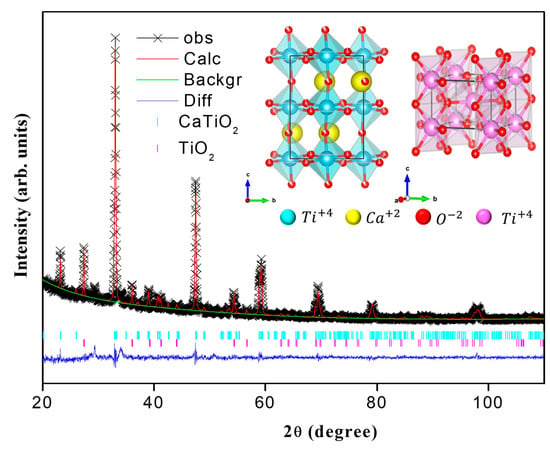
Figure 4.
Results of the XRD diffractogram fit, using Rietveld refinement of the system heat-treated at 900 °C. The inset shows the structure of the solid seen from plane ab. (The yellow sphere represents the Ca atoms; the blue, the titanium atom; and the red, the oxygen atom).
The structural parameters obtained are recorded in Table 1. The average particle diameter was calculated from some parameters refined using the Rietveld method through the GSAS 1.0.0 software, considering a spherical morphology for the particles and the wavelength of the CuKa radiation and averaging the perpendicular and parallel mean crystallite size. The average particle size for all the samples was close to 80 nm. The inset of the diffractogram in Figure 4 shows the structural model that was obtained using the Vesta 3.4.6 software, projected from the [002] plane. These structural models show the effect of the twist distortion of the TiO6 octahedral lattice, whose tolerance factor was recorded at 0.902. Calculation of the tolerance factor, for the sample synthesized in this work, was carried out using Equation (2).
where , , and are the ionic radii of calcium, titanium, and oxygen, respectively. Typically, for values of , the perovskite structure tends to have cubic symmetry with relatively right bond angles. Low values of the tolerance factor suggest a high degree of internal deformation due to the difference in size, leading to distorted perovskite structures [55]. To determine the tolerance factor, the ionic radii were used—1.97 Å for (cation A), 1.47 Å for (cation B), and 0.74 Å for O2− (anion) —and the results indicate that the factor is found in the interval of (see Table 3), for which it can be affirmed that the samples correspond to stable perovskites, with orthorhombic symmetry. This is due to the difference in values between the ionic radii of the Ca and Ti cations, which would propitiate the inclination and rotation of the octahedrons.

Table 3.
Main parameters of the system, obtained via XRD at room temperature.
It is important to consider the effect of the structural distortions of these systems on their different properties, which can be of two types, with the first related to the cooperative inclination of the octahedrons that is due to the effect of the size of the Ca cation within the unit cell, and the second type of distortion is due to the Jahn–Teller (JT) effect on the ions, which distorts the octahedrons in such a way that there are changes in the Ti-O bond length, and an increase in the angle of the at values close to 180° [56], as observed in the results in Table 3.
3.2.4. Nitrogen Adsorption and Desorption Isotherms
It has been observed that the surface area of inorganic molecules plays an important role in the catalytic activity of some contaminants. High surface areas lead to greater adsorption of the contaminant molecule on the surface of the catalyst and an improvement in its photocatalytic activity [57]. The most common methods to study pores, classifying them according to the IUPAC into micropores (<2 nm), mesopores (2–50 nm), and macropores (>50 nm), are low-temperature nitrogen sorption and mercury porosimetry [58]. The first method is based on nitrogen physisorption, which is the best known, validated, and accepted method for determining the specific surface area of the particles that are part of a solid. This technique uses Brunauer, Emmet, and Teller (BET) physical adsorption (physisorption) isotherms to determine the surface area and pore size distribution of different materials. In this type of isotherm, a layer of inert gas of a monomolecular thickness is formed, and on top of it, multilayers of gas are deposited that interact weakly through forces of the Van der Waals type. Its limitations are due to the fact that nitrogen sorption at 77 K in smaller micropores <0.7 nm occurs at relative pressures of , which requires high precision barometers and significantly longer equilibrium times. Furthermore, some materials are characterized by heterogeneities in the distribution of pores and nitrogen adsorption at low temperature, which does not allow for determining the global porosity, including the heterogeneity of the internal and external layers, affecting the specific area of the material [58]. The second method, called mercury porosimetry, determines the macroporosity (pore size > 50 nm), considering that sorption in the macropores occurs at pressures close to the condensation pressure, which does not allow its volume to be estimated with sufficient precision by means of gas sorption. This method is not applicable in the micro- and mesopore range, due to the limited pressure applied in the system.
In this research, the specific surface area, volume, and pore size distribution of the synthesized material were obtained through adsorption and the BET method. The corresponding adsorption–desorption isotherms of the CTO NPs are shown in Figure 5a; these can be classified as type IV curves, according to the IUPAC classification [40], and the shape of the hysteresis loop corresponds to the H3 type according to the same classification. This indicates that the CTO synthesized using the Pechini method can be classified as a mesoporous material. The presence of a quantity of micropores is also strongly indicated by the near-vertical adsorption isotherm at the lowest relative pressures analyzed, that is, in the range of (initial left part of Figure 5a). Specifically, the adsorption branch of this isotherm (Figure 5a) showed a gradual increase in the volume of gas absorbed, in the range of low relative pressures, from approximately to , subsequently showing a strong increase from to for higher relative pressures of the gas, a behavior that would indicate the presence of mesopores. The desorption branch of the isotherm is quite similar for values less than (Figure 5a). For higher values, a small hysteresis loop is observed, which would indicate the presence of mesopores.
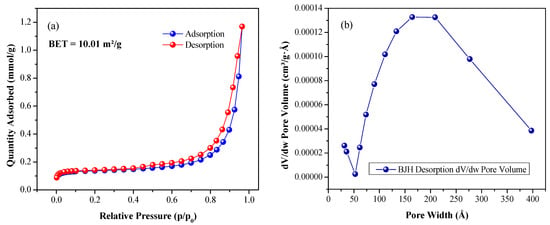
Figure 5.
(a) Adsorption and desorption isotherms of nitrogen; (b) pore size distribution curve.
To determine the surface area, the Brunauer, Emmet, and Teller (BET) method [59] was used, considering that the range of relative pressures where the adsorbate monolayer is formed and where the data fit the linearized form of the BET equation is from to . Thus, the results of the BET surface area measurement show a value of of CTO.
The results of the porosity analysis for the perovskite synthesized using the Pechini method, meanwhile, are indicated in the Barret–Joyner–Halenda (BJH) pore volume curve (Figure 5b); this shows a broad distribution centered at ~185 Å. To calculate the total pore volume and mean pore diameter, the desorption isotherm data were used. A total pore volume of and a mean pore diameter of were obtained. It is noteworthy that the largest number of pores present in the sample are larger than in Figure 5b, indicating that the synthesized CTO is a mesoporous material.
3.3. Optical Characterizations
3.3.1. Fourier Transform Infrared Spectroscopy
In order to analyze the effect of heat treatment on the synthesized ceramic powders of the system obtained using the Pechini method, IR spectra of the samples that were heat-treated at and were taken. Figure 6 shows three regions, with the first between and , which can be associated mainly with vibrational modes of the hydroxyl groups present in the sample. The second is between and and gives information about the vibrational modes of the carbon-containing bonds. The last region, would give information about the vibrational modes of the oxide of interest [49]. In the spectrum of Figure 6a, corresponding to the sample treated at , at around , the overlapping of the vibration bands of the hydroxyl group and the stretching vibration of the adsorbed water molecule can be observed [60,61]; the vibration corresponding to the bond is observed near as well as the vibrational modes due to the symmetrical stretching of the bond between y [62].
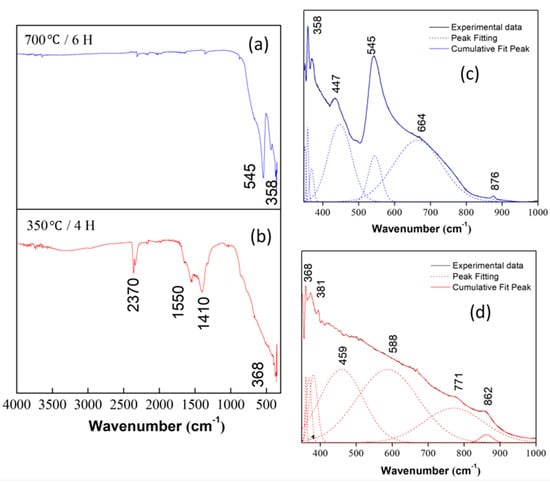
Figure 6.
IR spectra of the system heat-treated at (a) and (b) , (c,d) shows the result of the mathematical process of deconvolution, in the range between 350 and , of the IR spectra in (a) and (b), respectively, the solid black lines show the FTIR spectra, the blue and red dotted lines indicate the deconvolutions.
The bands below of Figure 6c,d, are mainly associated with functional groups that contain the bonds and that exist in the synthesized compounds. These bands correspond to bonds formed by titanium with other species and are, therefore, the area that provides more information about the nature of the complexes that exist in the system.
In addition, in the spectra in Figure 6a,b, it is observed that, when thermally treating the samples, the bands located between and decrease. This indicates that the heat treatment was effective in removing water or impurities from the system. If the IR spectra corresponding to the sample at and the one thermally treated at are compared, it can be concluded that, in the second spectrum, the formation of the structure corresponding to the system [63] was favored. Figure 6c,d show the deconvolutions of the spectra presented in Figure 6a,b, respectively; the vibrational modes associated with each band can be seen in Table 4.

Table 4.
Main vibrational modes and functional groups of .
In Figure 6b, the band around is assigned as an extension of the bond, characteristic of the vibration mode. This band is sensitive to a change in the angle of this bond, related to the octahedron of and, therefore, influenced by the phase shift with increasing temperature [47], the presence of a phase is also evident in the XRD analysis.
3.3.2. Raman Spectroscopy
The Raman spectrum corresponding to the CTO system treated at is indicated in Figure 7. The spectrum data underwent a deconvolution process using the Fityk 0.9.8 software, which was used to assign the possible active modes in Raman spectroscopy for the studied sample. It has been determined that these systems, with an orthorhombic structure of the space group (62), present 60 active Raman modes: twenty-eight associated with dipole moment changes , twenty-four symmetric and antisymmetric modes of stretching related to changes in polarizability , and eight modes concerned with cation substitution in site A [69,70,71].
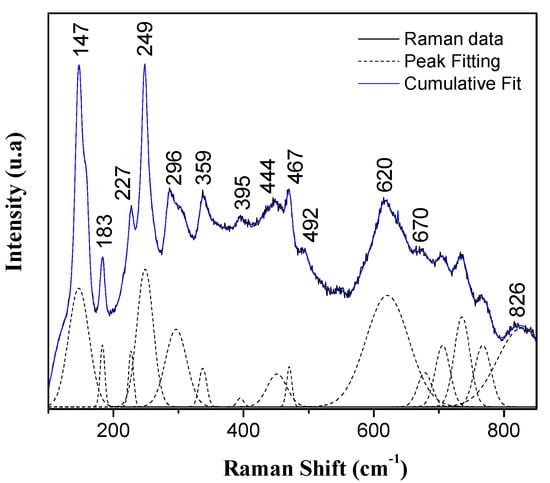
Figure 7.
Raman spectrum of the CTO system obtained at 700 °C. The solid black line shows the Raman data, the black dotted line corresponds the fitting result of the mathematical process of deconvolution and solid blue line indicates the cumulative fit.
Observing the spectra in Figure 7, a first band located at can be highlighted, associated with the translation vibration mode between the and ions within the structure [72]. Subsequently, the bands located at , , , , , , and can be attributed to active vibrational modes, , associated with the bending modes of , which have been widely reported for the system [69,73,74].
In the spectra, it is possible to observe bands located at that can be attributed to the torsional vibration modes, , in the bonds; these modes are related to the internal vibration of the oxygen cage of the structure [73,74]. Finally, the bands at are observed, corresponding to the stretching mode in the bond [69] and a band close to , associated with the substitution of the calcium ion within the perovskite structure [70]. These results show the effect of the angular deformation of the bonds, characteristic of the orthorhombic phase observed in the XRD diffractograms of the samples (See Figure 4).
3.3.3. Diffuse Reflectance Spectroscopy
The system gives a white color, indicating an absorption capacity in the visible light range, a behavior that was evidenced by observing the results of spectroscopy in the UV–visible range that were obtained for this system (Figure 8a). A deconvolution process was carried out to determine the different absorption bands in the UV-Vis spectra of the sample of interest. This system showed UV light absorption mainly at the and nm wavelengths (Figure 8b). These UV absorption bands are generated by the intermolecular transition process of charge transfer of the π → π∗ orbitals, a result that is consistent with what has been observed in the literature [53,60]. The band at is due to light absorption caused by the excitation of electrons from the valence band to the conduction band of [75].
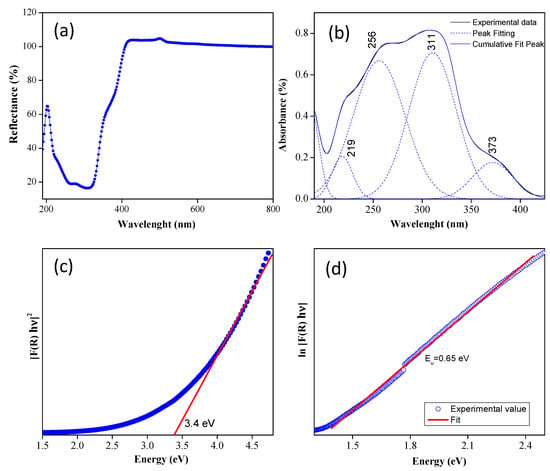
Figure 8.
(a) DRS UV-Vis spectra corresponding to powders of the systems, (b) deconvolution of the absorbance spectrum, (c) bandgap energy obtained using the Kubelka–Munk function, and (d) determination of Urbach energy () from the graph vs. .
The bandgap energy value was determined from the Kubelka–Munk function, which can be expressed in the following equation:
where is the Kubelka–Munk function, is Planck’s constant, is the frequency of light, is the absorption constant, and is the coefficient associated with the electronic transition that can take values of ½ and 2, if the transition is direct or indirect, respectively. In this case, was considered because these particles could present direct transitions; the value was calculated from the resulting curve by plotting as a function of , extrapolating the linear part towards the abscissa axis.
Figure 8c shows the transformation of the Kubelka–Munk function, the result from which a value of the energy bandgap of 3.4 eV was obtained, considering a direct transition, which is important to avoid an increase in the recombination of the electron–hole pair, which potentiates these materials for their use in photocatalytic activity [61]. When the obtained in this work is compared for powders synthesized using the Pechini polymeric precursor method, with respect to the values reported for systems synthesized through the hydrothermal and sol–gel methods, with values of and , respectively [53], it is observed that there were no significant changes in the gap energy value.
Finally, the Urbach energy ) was determined, originated by the states located in the bandgap, which is related to the disorder in the structure and is given as , where α is the absorption coefficient proportional to , is the photon energy, and the Urbach energy. From the results obtained from the Kubelka–Munk function, it is possible to calculate the Urbach energy by plotting against . The reciprocal of the slope of the fit of the linear part of this curve, Figure 8d, observed below the optical band gap, will be equal to the value of . The calculated Urbach energy presented a value of 0.65 eV, a result that indicates a greater disorder in its structure and/or a greater contribution of the defects to the states located in the band gap.
3.3.4. Photoluminescence Spectroscopy
Figure 9 presents the photoluminescence (PL) spectra corresponding to the system, synthesized at 700 °C, using two excitation wavelengths of (Figure 9a) and (Figure 9b). The PL emission can change due to the presence of defects such as oxygen vacancies (VO) and Ti vacancies (VTi) that affect the optical properties of these systems. Figure 9 shows that the perovskite exhibits strong luminescence upon ultraviolet excitation.
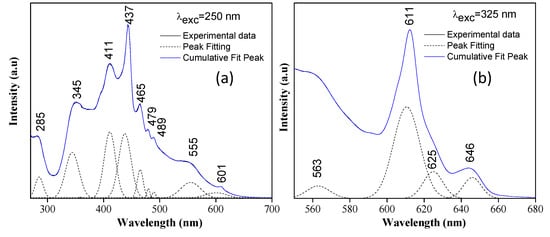
Figure 9.
CaTiO3 photoluminescence spectra obtained with excitation lengths 250 nm (a) and 325 nm (b). The solid black line shows the experimental data, the black dotted line corresponds the fitting result of the mathematical process of deconvolution and solid blue line indicates the cumulative fit.
In the emission spectrum of Figure 9a, a broad band of luminescence is observed in the range of , showing that these systems present a strong emission in the visible light region. The PL spectrum of Figure 9a was characterized by two bands located at () and (), both in violet, with the former attributed to emission from the intermediate state directly below the conduction band [76] and the latter to the delocalized electronic levels associated with the transfer of charge between the bands, due to the effects of the crystalline field of the material [77]. The bands between and (blue), meanwhile, are characteristic of systems with perovskite structures. These bands were related to the radioactive recombination of the electron–hole pair trapped in the octahedral structural unit of in the , known as the self-trapped exciton (STE) state [76]. In the spectrum, it is possible to observe bands between and with a lower emission intensity, an effect attributed to the recombination rate of the electron–hole pairs, and which can improve the photocatalytic activity [61]. A band appears in this region at corresponding to orange (2.1 eV), which indicates the presence of ions located in octahedral sites, related to the strong crystalline field of the structure. Furthermore, these bands suggest the presence of surface defects and oxygen vacancies in the system [60,78].
In Figure 9b, the emission spectrum obtained with a excitation source is shown, the spectrum presents a luminescence band in the range of , with defined maxima at (orange/2.03 eV) and (red/1.92 eV). The profile obtained may be due to the participation of numerous states within the bandgap of the material, caused by intrinsic defects in the material [44,73]. These defects are directly related to the oxygen vacancies in complex groups or in the torsion of the bonds between the groups [79]. The presence of titanium ions, and the structural defects of these systems, together with the value of obtained from the diffuse reflectance spectroscopy tests (Figure 8c), suggest that the studied system presents a semiconductor behavior with potential applications in photocatalysis [44] and optical devices [77]. Table 5 summarizes the possible defects associated with the bands of the PL spectra.

Table 5.
Possible defects present in the CTO sample.
3.4. Methyl Orange (MO) and Levofloxacin (LVF) Photodegradation Tests
3.4.1. Determination of Calibration Curves
To evaluate the degradation capacity of MO and LVF by the compounds, the UV-Vis spectroscopy technique was used. Initially, the relationship between the absorbance recorded with the spectrophotometer and the concentration of each contaminant was determined, obtaining the respective calibration curves. UV-Vis absorption spectra were obtained using a Jasco V700 UV-VIS spectrophotometer, in the range of 200–600 nm.
Initially, a stock solution of MO was prepared at 1000 ppm (mg/L) in deionized water. From this, a 10 ppm dilution was obtained and its UV/Vis spectrum was determined (see Figure 10a), in which the intensity (absorbance value) corresponding to the maximum absorption peak at a wavelength value of ~464 nm was recorded, a parameter that was chosen to determine the concentration of MO in aqueous solutions. MO solutions between 1 ppm and 10 ppm (Figure 10a) were made in order to determine the UV/Vis spectroscopy calibration curve, which allowed for the measuring of the absorbance as a function of concentration, as indicated in Figure 10b. It can be seen that the fit of the curve is maintained with an adequate linear regression parameter ().
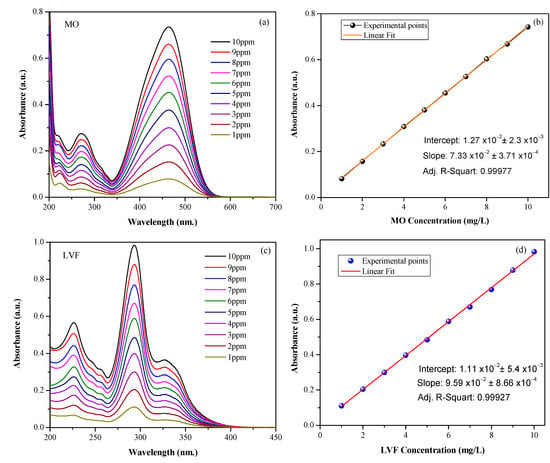
Figure 10.
UV-Vis absorption spectra corresponding to solutions of (a) MO and (c) LVF in concentrations between 1 and 10 ppm. Calibration curves of (b) MO and (d) LVF to determine the amount of contaminant present in a solution using the maximum peak absorbance value ( for MO and for LVF).
A stock solution of LVF was prepared in a similar way at 2000 ppm (mg/L) in demineralized water. From this, a 10 ppm dilution was obtained and its UV/Vis spectrum was determined (Figure 10c). In the LVF spectrum, two absorption peaks were identified in the ultraviolet region with maximums at ~226 nm and 293 nm. The second one presents a much higher relative intensity, which is why it was decided to work at this wavelength to determine the LVF concentration in aqueous solutions. LVF solutions were made between 1 ppm and 10 ppm (Figure 10c) and a calibration curve was obtained (Figure 10d) with an appropriate linear regression parameter ().
3.4.2. MO and LVF Degradation Kinetics
The photocatalytic activity of the CTO was investigated using MO and LVF as target molecules. Initially, the pollutant degradation test was performed in the absence of a photocatalyst to confirm whether the degradation of MO and LVF was photocatalytic or photolytic in nature. Solutions of 50 mL at 10 ppm of each of the contaminants were prepared, and they were placed in a photoreactor equipped with a UV lamp; aliquots of the solutions were taken at 15 min intervals and the absorbance spectra were measured. It was observed that MO and LVF are stable under UV radiation; Figure 11a, b shows the photolysis of MO and LVF, respectively, Figure 11 indicates that there was no representative change in the aqueous solution with the contaminants exposed to radiation in either case. The UV-Vis spectra of the aliquots of the solutions taken at different times were similar, which means that the degradation of MO and LVF due to the effect of radiation can be considered insignificant.
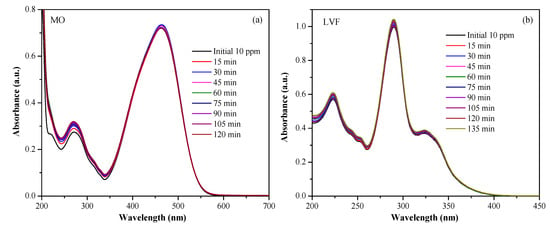
Figure 11.
Photolysis of MO (a) and LVF (b).
The graphs of the degradation of MO and LVF, using the CaTiO3 nanoparticles at different concentrations, are presented in Figure 12 and Figure 13, respectively, Figure 12a–d and Figure 13a–d present the degradation of the contaminants for catalyst doses of 3,5,10 and 15 g/L, respectively. Initially, the CTO NPs are brought into contact with the contaminants under constant stirring for 30 min and in the absence of radiation to establish the adsorption–desorption equilibrium. After this time, an aliquot of the solution is taken, the NPs are removed via centrifugation, and the absorption spectrum is measured. These measurements are labeled as 0 min in Figure 12 and Figure 13. Once the adsorption–desorption equilibrium is established, the UV lamp is switched on. The results show a decrease in the absorption maximum as the time of exposure to UV radiation increases, which indicates the degradation of the pollutants. The kinetic mechanism most associated with photocatalysts with a composition similar to that of this work, acting on organic compounds, is the first-order linear mechanism [16,80,81,82]. This model, also known as the “Langmuir−Hinshelwood mechanism” describes photocatalytic degradation, including the sorption effect. In this model, the reagents are adsorbed on the active sites before the start of the reaction [83]. The expression that explains the kinetics of the catalytic processes is given through the pseudo-first-order equation (Equation (4)):
where is the kinetic degradation constant, also called the apparent rate constant (Kapp, min−1), Co and Cf are the initial concentration of the pollutant (mg/L) at time 0 and during irradiation at time t, respectively, and t is the time (min) [81,83].
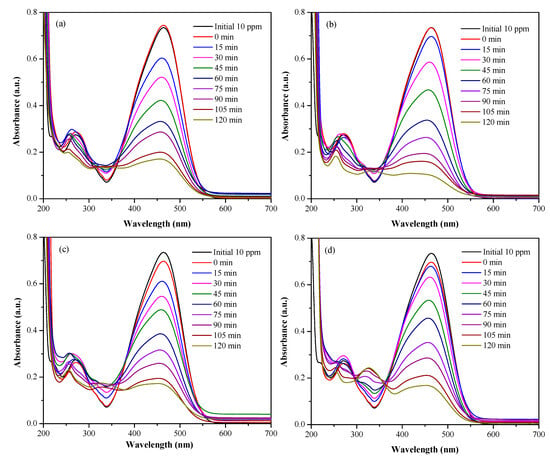
Figure 12.
UV-Vis absorption spectra corresponding to solutions of MO and CaTiO3 nanoparticles in concentrations of (a) 3 g/L, (b) 5 g/L, (c) 10 g/L, and (d) 15 g/L.
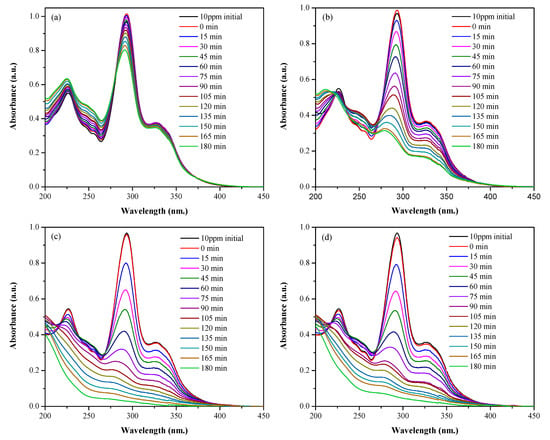
Figure 13.
UV-Vis absorption spectra corresponding to LVF solutions and CaTiO3 nanoparticles at concentrations of (a) 3 g/L, (b) 5 g/L, (c) 10 g/L, and (d) 15 g/L.
Figure 14a–d show the kinetic study, using the nanoparticles of the CTO system. The value of the apparent velocity constants (K) is calculated from the slope of the graph of versus time, using the expression in Equation (4). The kinetic parameters for the degradation of MO and LVF, the K values, and the calculated fit factors are shown in Figure 14c,d and in Table 6. The results revealed that the MO and LVF photodegradation process is consistent with the pseudo-first-order reaction kinetics model.
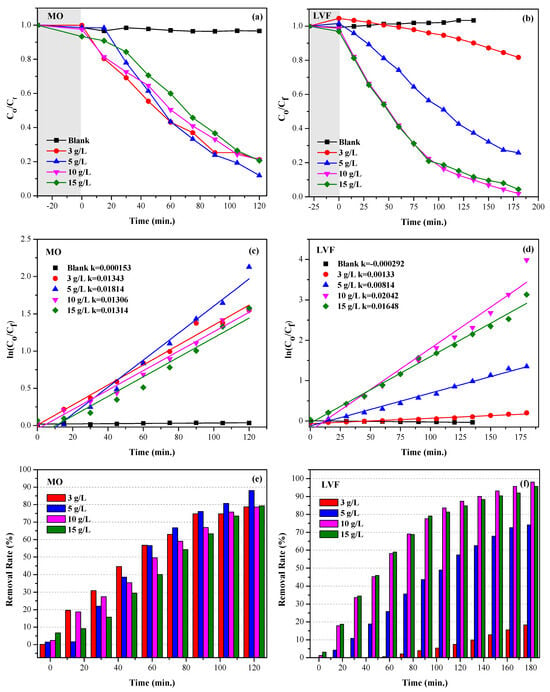
Figure 14.
(a,b) Photocatalytic activity of CTO with MO and LVF for different catalyst concentrations. (c,d) Graphs of photocatalytic degradation kinetics and determination of reaction rate constant. (e,f) Percentages of degradation as a function of time.

Table 6.
Parameters obtained from the fit to a first-order kinetic equation and the percentage of degradation of MO and LVF.
Measurements made at 0 min (Figure 12 and Figure 13) indicate that, in the absence of light, the CTO samples do not exhibit contaminant adsorption. However, upon irradiation with ultraviolet light in the presence of the nanoparticles, the contaminants undergo a marked degradation. Figure 14c,d show that for MO and LVF, the maximum CTO reaction rate constants are and , respectively. After 2 h of treatment with CTO and UV irradiation (Figure 14c, Table 6), the dye degradation rate reached 78.8, 88.1, 78.7, and 79.4%, for concentrations of 3, 5, 10, and 15 , respectively. When the catalyst dose is increased from 3 to 5 , the active sites increase; therefore, the percentage of degradation increases. If the dose continues to increase, the degradation efficiency decreases. This may be due to the fact that the excess of catalyst in the solution hinders the transmission of light.
Similarly, in Figure 14c and Table 6, we observe that the degradation rates of the antibiotic after 3 h of irradiation reach % for concentrations of 3, 5, 10, and 15 , respectively. If the dose of the catalyst is increased from 3 to 10 , the percentage of LVF degradation increases, but if the CTO dose is raised to 15 , the degradation efficiency decreases. This implies that 5 and 10 are the optimal catalyst doses for the MO and LVF degradation systems, respectively.
To explain the results of the MO and LVF degradation by the CTO-NPs, it is pertinent to initially consider the adsorption process of MO and LVF molecules on the surface of the NPs. Despite the small particle size of these solids (Figure 3), and the specific area reported in the BET analyses, the adsorption process was not very important (Figure 12 and Figure 13); however, photocatalytic activity was found to occur.
To account for the possible fundamental mechanisms of photocatalysis of CTO, we ought to bear in mind that the synthesized material is a semiconductor that shows optical absorption in the UV region of the spectrum , with a bandgap energy value of (Figure 8). Figure 15 schematically shows the photocatalytic mechanism of the CTO in the degradation of MO. When the CTO is photoinduced using sunlight with a photon energy () equal to or greater than the bandgap energy (), the electrons in the valence band (VB) are promoted to the conduction band (CB). Therefore, highly active electrons are generated in the CB, and positively charged holes (h+) are formed in the VB [46]. Simultaneously, a fraction of the photogenerated and h+ recombines. Only those that survive recombination reach the semiconductor surface and interact with the dissolved oxygen to form the superoxide radical anion (). The conduction band potential of the CTO is calculated to be vs. a normal hydrogen electrode (NHE) using the following relation [84]:
where is the absolute electronegativity of the CTO (estimated to be , according to the data reported in the literature [84]), is the energy of free electrons on the hydrogen scale (), and is the bandgap energy of the CTO () [84].
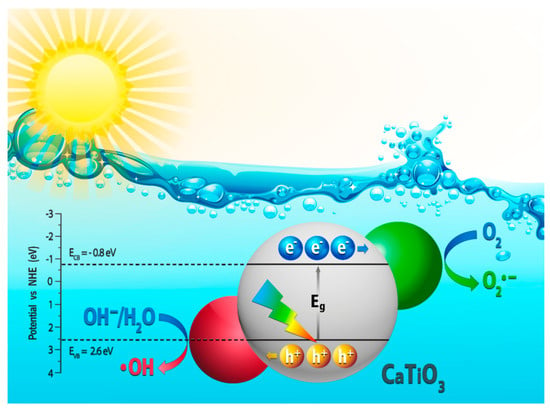
Figure 15.
Schematic illustration of the photocatalytic mechanism of the CTO NPs.
Moreover, the water molecules adsorbed on the surface of the CTO interact with to form hydroxyl radicals [31]. The CB background of CTO () is more negative than the standard redox potential of (−0.33 eV), indicating that these excited electrons in the CB of CTO can react with adsorbed oxygen and generate [10]. Furthermore, the potential of the VB of the CTO is more positive than that of the H2O/•OH (1.99 eV), so the in the VB of the CTO can react with to generate [10]. The and radicals have strong oxidizing properties and can decompose organic pollutants into other intermediates or small molecules such as , and mineral acids [16,46]. The degradation processes are the following (Equations (6)–(10)):
For comparison, Table 7 presents the photocatalytic performances of the CTO nanoparticles used in the degradation of some pollutants that have been reported in the literature. The results obtained with the particles synthesized using the polymeric precursor method reported in this work had a lower efficiency of degradation of MO, with a degradation percentage of at a concentration of and a time of 120 min, compared to other chemical methods, such as the thermal method with an efficiency of 99.03% at a concentration of and a time of 40 min [85]. Generally, several parameters inhibit degradation, including the amount of the catalyst, the reaction temperature, the pH, the nature and concentration of contaminants, and the nature of inorganic ions [85]. As shown in Table 7, the amount of the CTO photocatalyst used to degrade MO in the present work was greater than those reported for similar systems, which would affect the speed of the photocatalytic reaction; that is, when the amount of the photocatalyst is greater than the saturation point, the light photon adsorption coefficient decreases and, consequently, the photocatalytic efficiency decreases, inhibiting degradation [44]. Moreover, it has been reported that the morphology of the nanoparticles affects the photocatalytic performance and efficiency of the degradation of the MO dye. As could be seen in the SEM images in Figure 3, in the present study, granulated nanoparticles with an irregular morphology were obtained at a lower efficiency in the degradation of MO, while those obtained using the thermal method for the same system [86], with a rod-like morphology, achieved double the photocurrent density versus granulated CTO particles, resulting in a greater inhibition of the charge carrier recombination and greater photocatalytic activity. This effect may be related to the increase in the surface area of the particles, which was in this work, compared to higher values of CTO systems, obtained through the hydrothermal method, with a surface area of , at an efficiency of 96.6% in 60 min, by dispersing 0.1 g of CTO in 200 mL of an aqueous solution of 10 mg/L of MB. It has been proposed that a higher surface area value promotes the generation of active species (, , ) to decompose contaminants [53].
Another factor to consider is the variation in pH, which can influence the adsorption of the contaminant molecule on the surface of the CTO. Acidic solutions (pH < 5) inhibit degradation due to the high concentration of protons. Studies show that the removal rate of methyl blue increases with increasing solution pH, given that the MO contaminant is a positively charged cationic system, which is more easily attracted to the surface of the material through the electrostatic interaction in alkaline conditions, favoring its degradation. That is, under neutral and alkaline conditions, it can be removed up to almost 100% [16]. This same study revealed that by synthesizing a heterojunction with 40% , 87.7% of LVF can be removed in a time of 120 min with a concentration of 20 mg/L at pH 7. This behavior is due to the fact that LVF molecules behave like zwitterions at pH values of , which facilitates the reaction of in the VB of the CTO with to generate , and , these active species have strong oxidant properties and can decompose contaminants such as LVF, mainly through the oxidation of the piperazine ring, that finally decomposes into amines and carboxylic acids, which are small compounds that, over time, could mineralize into small molecules. The opposite happens at pH 9–11, since LVF molecules behave like anions, repelling electronegative material, resulting in lower removal rates; that is, the alkaline state exerts an obvious inhibitory effect on LVF degradation [16,87].
Therefore, it is necessary to make adjustments to the synthesis conditions of the CTO nanoparticles, which allow for the control of the morphology of the particles and an increase in the surface area. Some alternatives to be considered may be the doping or composition of heterostructures with some metallic elements, including Zr [88], Fe [89], Ag [65], graphene [84], and g-C3N4 [90], which have shown an increase in photocatalytic activity. These results suggest possible alternatives for producing CTO with a higher percentage of degradation of emerging contaminants such as LVF in the future.

Table 7.
Some methods of synthesis for obtaining the CaTiO3 system.
Table 7.
Some methods of synthesis for obtaining the CaTiO3 system.
| System | Method of Synthesis | Parameter of Synthesis | (eV) | Emerging Pollutant | Irradiation | Efficiency (%) | Ref | |
|---|---|---|---|---|---|---|---|---|
| Sol–gel | Precursor: Calcium chloride (CaCl2), Titanium (IV) isopropoxide [Ti(OC4H9)4] 700 °C/2 h | 2.95 | 48.2 | MO | 100 min Light source: 500 W Xe lamp (470 nm). | 62% 10 mg/50 mL of 5 mg/L | [60] | |
| 900/2 h | 2.82 | 73.4 | MO | 88% 10 mg/50 mL of 5 mg/L | ||||
| Microwave-assisted method | Precursor: Calcium acetate Ca(CH3COO)22H2O, Titanyl sulfate TiO(SO4.) Microwave irradiation at 400 W | 2.67 | - | MB | 240 min Light source: 6 W Hg lamp (254 nm) | 96.4% 0.1 g in 20 ppm de MB dye | [44] | |
| Polyacrylamide gel route | Precursor: calcium nitrate Ca(NO3)24H2O, Titanium Tetrabutoxide Ti(C4H9O)4Chelating agent: Ethylenediaminetetraacetic acid (EDTA) 600 °C/6 h | 3.66 | 60.5 | MO | 180 min Light source: 15 W low-pressure mercury lamp (254 nm) | 96% 0.1 g/100 mL of 1 mg/L | [91] | |
| Solid state | Precursor: calcium carbonate CaCO3, titanium oxide TiO2 1400 °C/3 h | 3.18 | 0.10 | MB | 60 min Light source: 500 W Hg lamp | 0.1 g/200 mL of 10 mg/mL | [53] | |
| Sol–gel | Precursor: calcium nitrate tetrahydrate Ca(NO3)2·4H2O, Tetrabutyl titanate Ti(C4H9O)4 700 °C/3 h | 3.42 | 9.69 | MB | 0.1 g/200 mL of 10 mg/mL | |||
| Hydrothermal | Precursor: calcium nitrate tetrahydrate Ca(NO3)2·4H2O, Tetrabutyl titanate Ti(C4H9O)4 200 °C/24 h. | 3.49 | 18.20 | MB | 96.6% 0.1 g/200 mL of 10 mg/mL | |||
| Thermal method | Precursor: calcium nitrate Ca(NO3), Tetra-n-butyl titanate C16H36O4Ti 700 °C/5 h | 3.08 | - | MO | 40 min Light source: 500 W, Xe lamp | 99.03% 15 mg/50 mL of 10 mg/L (0.3 g/L) | [86] | |
| Hydrothermal | 180 °C/12 h Precursor: titanium isopropoxide | 3.65 | 108.14 | Arsenite [As(III)] | 40 min Light source: UV light irradiation (254 nm) | 98.4% 80 mg/80 mL of 2 mg/L | [92] | |
| Hydrothermal | 180 °C/24 h Precursor: tetrabutyltitanate (TNB), calcium nitrate and melamine. Composition: CTO/40%CN | 3.35 | - | LVF | 120 min Light source: 500 W low-pressure mercury lamp (254 nm) | 87.7% 0.4 g/L | [93] | |
| Polymeric precursor method | Precursor: calcium acetate [Ca(C2H3O2)2], titanium butoxide (C16H36O4Ti) 700 °C/2 h | 3.44 | 34.6 | MB | 180 min Light source: 125 W mercury lamp | 69% 1.0 g/L and pH of 11.2 | [43] | |
| Polymeric precursor method | Precursor: titanium tetrabutoxide ]4, and calcium acetate (700 °C/6 h | 3.4 | 10.01 | MO | 120 min Light source: UV lamp | 88.1% 5 g/L and pH of 6.2 | This work | |
| LVF | 120 min Light source: UV lamp | 98.1% 10 g/L and pH of 4.5 |
4. Conclusions
In this work, CTO-NPs were successfully synthesized using the Pechini chemical method at 700 °C with a reproducible, controlled methodology. From the XRD results carried out on the catalyst, the coexistence of two crystalline phases is concluded: a majority perovskite-type phase with a orthorhombic structure and a minority rutile-type phase of with a structure, with a crystallite size of ~84 . The Raman spectra revealed the effect of the distortions in the lattice associated with defects in the structure such as oxygen vacancies, the twisting of the bonds between the TiO6-TiO6 groups, or the presence of ions located in octahedral sites, defects that were also observed in the PL spectrum. These particles presented a mesoporous structure, with a surface area of and a pore size of , where an irregular morphology predominated, as well as a high degree of agglomeration. From the UV-Vis DRS analyses, an energy gap of was obtained for the CTO, characteristic of semiconductor materials. Regarding the evaluation of the photodegradation capacity of the nanoparticles obtained on the CEs studied, MO and LVF, with continuous UV radiation, it was found that ~88.1% of the MO degraded with a CTO concentration of 5 g/L (for 2 h of treatment) and ~98.1% of LVF degraded with 10 g/L of CTO (for 3 h of treatment). The kinetics of the reactions were determined to be well represented by pseudo-first-order kinetics. This high photocatalytic performance was attributed to the intrinsic characteristics of CTO, its surface area, and the presence of defects in the structure, which could be active sites or modify the electronic structure, either directly or indirectly increasing its photocatalytic characteristics. This work contributes to the development of green and efficient technologies applied to the area of environmental remediation, particularly to bringing forward friendly, efficient catalysts for the degradation of emerging contaminants, a topic of great current interest.
Author Contributions
Conceptualization, L.C.-U.; methodology, L.C.-U. and C.J.A.; analysis, L.C.-U. and C.J.A.; writing—original draft preparation, L.C.-U. and C.J.A.; writing—review and editing, C.J.A., J.E.D., and E.M.-V.; resources, J.E.D. and E.M.-V. All authors have read and agreed to the published version of the manuscript.
Funding
The APC was funded by the General Royalty System through the project SGR BPIN 2021000100424, Strengthening of the CENM-INCIMAR Alliance to increase the capacity for research and technological development in the remediation of emerging pollutants in Valle del Cauca.
Data Availability Statement
Data are contained within the article.
Acknowledgments
The authors are grateful for the financial support of the CTel Fund (General Royalty System) through the projects SGR BPIN 2021000100424, Strengthening of the CENM-INCIMAR Alliance to increase the capacity for research and technological development in the remediation of emerging pollutants in Valle del Cauca, and BPIN 2020000100377, Research for the recovery of plastic waste (upcycling) through the development of products based on carbonaceous nanomaterials that result in an increase in the competitiveness of the Pacific region in Cauca, Valle del Cauca. We are furthermore grateful to the Universidad del Valle and its Vice-Rector’s Office for Research and the Center of Excellence in New Materials (CENM), for their support in the administrative processes, management, and use of laboratories. L. Cerón Urbano thanks J.C. Sinisterra for the measurement of the nitrogen adsorption and desorption isotherms.
Conflicts of Interest
The authors declare no conflict of interest.
References
- Gil, M.J.; Soto, A.M.; Usma, J.I.; Gutiérrez, O.D. Contaminantes Emergentes En Aguas, Efectos y Posibles Tratamientos. Prod. Limpia 2012, 7, 52–73. [Google Scholar]
- Fu, X.; Zhou, G.; Li, J.; Yao, Q.; Han, Z.; Yang, R.; Chen, X.; Wang, Y. Critical Review on Modified Floating Photocatalysts for Emerging Contaminants Removal from Landscape Water: Problems, Methods and Mechanism. Chemosphere 2023, 341, 140043. [Google Scholar] [CrossRef] [PubMed]
- Jacobo-Marín, D. Contaminantes Emergentes En El Agua: Regulación En México, Principio Precautorio y Perspectiva Comparada. Rev. Derecho Ambient. 2021, 15, 51–76. [Google Scholar] [CrossRef]
- Sandoval, J.A.; Morales-Granados, M.A.; Rubio, D. Breve Revisión Del Uso de Microalgas Para La Remoción de Contaminantes Emergentes En Aguas Residuales. Gestión Ambient. 2020, 23, 127–137. [Google Scholar] [CrossRef]
- Andrea, J.; Urbina, J.; Augusto, J.; Solano2, V. Los Contaminantes Emergentes de Las Aguas Residuales de La Industria Farmacéutica y Su Tratamiento Por Medio de La Ozonización. Inf. Técnico 2020, 84, 249–263. [Google Scholar] [CrossRef]
- Intisar, A.; Ramzan, A.; Hafeez, S.; Hussain, N.; Irfan, M.; Shakeel, N.; Gill, K.A.; Iqbal, A.; Janczarek, M.; Jesionowski, T. Adsorptive and Photocatalytic Degradation Potential of Porous Polymeric Materials for Removal of Pesticides, Pharmaceuticals, and Dyes-Based Emerging Contaminants from Water. Chemosphere 2023, 336, 139203. [Google Scholar] [CrossRef] [PubMed]
- Li, X.; He, F.; Wang, Z.; Xing, B. Roadmap of Environmental Health Research on Emerging Contaminants: Inspiration from the Studies on Engineered Nanomaterials. Eco-Environ. Health 2022, 1, 181–197. [Google Scholar] [CrossRef]
- Veiga-del-Baño, J.M.; Cámara, M.Á.; Oliva, J.; Hernández-Cegarra, A.T.; Andreo-Martínez, P.; Motas, M. Mapping of Emerging Contaminants in Coastal Waters Research: A Bibliometric Analysis of Research Output during 1986–2022. Mar. Pollut. Bull. 2023, 194, 115366. [Google Scholar] [CrossRef]
- Fernández González, E. Toxicidad de Contaminantes Emergentes Farmacéuticos Sobre la Microalga Modelo Chlamydomonas Reinhardtii; Universidade da Coruña: Coruña, Spain, 2023. [Google Scholar]
- Sharma, A.; Kumar, N.; Mudhoo, A.; Garg, V.K. Phytobiomass-Based Nanoadsorbents for Sequestration of Aquatic Emerging Contaminants: An Overview. J. Environ. Chem. Eng. 2023, 11, 109506. [Google Scholar] [CrossRef]
- Puri, M.; Gandhi, K.; Kumar, M.S. Emerging Environmental Contaminants: A Global Perspective on Policies and Regulations. J. Environ. Manag. 2023, 332, 117344. [Google Scholar] [CrossRef]
- Hu, X.; Gong, S.; He, Q.; Wu, J.L.; Li, N. Less Is More: A New Perspective for Toxicity of Emerging Contaminants by Structures, Protein Adducts and Proteomics. TrAC Trends Anal. Chem. 2023, 167, 117289. [Google Scholar] [CrossRef]
- Silva, E.C.; Soares, V.R.; Fajardo, A.R. Removal of Pharmaceuticals from Aqueous Medium by Alginate/Polypyrrole/ZnFe2O4 Beads via Magnetic Field Enhanced Adsorption. Chemosphere 2023, 316, 137734. [Google Scholar] [CrossRef] [PubMed]
- Shearer, L.; Pap, S.; Gibb, S.W. Removal of Pharmaceuticals from Wastewater: A Review of Adsorptive Approaches, Modelling and Mechanisms for Metformin and Macrolides. J. Environ. Chem. Eng. 2022, 10, 108106. [Google Scholar] [CrossRef]
- Afsa, S.; Vieira, M.; Nogueira, A.F.; ben Mansour, H.; Nunes, B. A Multi-Biomarker Approach for the Early Assessment of the Toxicity of Hospital Wastewater Using the Freshwater Organism Daphnia Magna. Environ. Sci. Pollut. Res. 2021, 29, 19132–19147. [Google Scholar] [CrossRef]
- Zhao, J.; Cao, X.; Bai, Y.; Chen, J.; Zhang, C. Simple Synthesis of CaTiO3/g-C3N4 Heterojunction for Efficient Photodegradation of Methylene Blue and Levofloxacin. Opt. Mater. 2023, 135, 113239. [Google Scholar] [CrossRef]
- Zhao, Y.; Guo, H.; Liu, J.; Xia, Q.; Liu, J.; Liang, X.; Liu, E.; Fan, J. Effective Photodegradation of Rhodamine B and Levofloxacin over CQDs Modified BiOCl and BiOBr Composite: Mechanism and Toxicity Assessment. J. Colloid Interface Sci. 2022, 627, 180–193. [Google Scholar] [CrossRef] [PubMed]
- He, M.; Chen, J.; Yang, Y.; Hu, X.; Jiang, Z.; Yan, Y.; Sun, J.; Fu, L.; Wei, J.; Yang, T. Coupling Plasmonic Effect into Stable AgCl/NH2-MIL-68In Z-Scheme Heterojunction System for Efficient Photodegradation of Levofloxacin. Opt. Mater. 2023, 137, 113554. [Google Scholar] [CrossRef]
- Varma, K.S.; Shukla, A.D.; Tayade, R.J.; Mishra, M.K.; Nguyen, V.H.; Gandhi, V. Interaction of Levofloxacin with Reverse Micelle Sol-Gel Synthesized TiO2 Nanoparticles: Revealing Ligand-to-Metal Charge Transfer (LMCT) Mechanism Enhances Photodegradation of Antibiotics under Visible Light. Mater. Lett. 2022, 309, 131304. [Google Scholar] [CrossRef]
- Yang, X.; Hesami, M.D.; Nazemipool, E.; Bahadoran, A.; Al-Bahrani, M.; Azizi, B. Fabrication of CuCo2S4 Yolk-Shell Spheres Embedded with S-Scheme V2O5-Deposited on Wrinkled g-C3N4 for Effective Promotion of Levofloxacin Photodegradation. Sep. Purif. Technol. 2022, 301, 122005. [Google Scholar] [CrossRef]
- Regraguy, B.; Ellouzi, I.; Mabrouki, J.; Rahmani, M.; Drhimer, F.; Mahmou, C.; Dahchour, A.; El Mrabet, M.; El Hajjaji, S. Zinc Doping of Different Nanoparticles of TiO2 Sachtopore for Improved Elimination of the Methyl Orange by Photocatalysis. Emergent Mater. 2022, 5, 1945–1958. [Google Scholar] [CrossRef]
- Juárez Ramírez, I.; Torres Martínez, L.M.; López, A.C.; Garza Tovar, L.L.; Meza De La Rosa, M.E. Nanopartículas Semiconductoras: Una Alternativa para la Degradación de Contaminantes Orgánicos Presentes en Agua Residual y la Generación de Energía de Manera Sustentable; Ciencia UANL: San Nicolás de los Garza, Mexico, 2008; Volume XI, pp. 411–422. [Google Scholar]
- Okoye, C.O.; Nyaruaba, R.; Ita, R.E.; Okon, S.U.; Addey, C.I.; Ebido, C.C.; Opabunmi, A.O.; Okeke, E.S.; Chukwudozie, K.I. Antibiotic Resistance in the Aquatic Environment: Analytical Techniques and Interactive Impact of Emerging Contaminants. Environ. Toxicol. Pharmacol. 2022, 96, 103995. [Google Scholar] [CrossRef] [PubMed]
- Jia, Y.; Ding, L.; Ren, P.; Zhong, M.; Ma, J.; Fan, X. Performances and Mechanism of Methyl Orange and Congo Red Adsorbed on the Magnetic Ion-Exchange Resin. J. Chem. Eng. Data 2020, 65, 725–736. [Google Scholar] [CrossRef]
- Osugi, M.E.; Rajeshwar, K.; Ferraz, E.R.A.; de Oliveira, D.P.; Araújo, Â.R.; Zanoni, M.V.B. Comparison of Oxidation Efficiency of Disperse Dyes by Chemical and Photoelectrocatalytic Chlorination and Removal of Mutagenic Activity. Electrochim. Acta 2009, 54, 2086–2093. [Google Scholar] [CrossRef]
- Stevović, S.; Nestorović, Ž.; Đurić, N. Nanotechnology in the Function of Sustainable Water Use. Contemp. Mater. 2020, 11, 102–111. [Google Scholar] [CrossRef]
- Liang, C.Z.; Sun, S.P.; Li, F.Y.; Ong, Y.K.; Chung, T.S. Treatment of Highly Concentrated Wastewater Containing Multiple Synthetic Dyes by a Combined Process of Coagulation/Flocculation and Nanofiltration. J. Memb. Sci. 2014, 469, 306–315. [Google Scholar] [CrossRef]
- Kono, H.; Kusumoto, R. Removal of Anionic Dyes in Aqueous Solution by Flocculation with Cellulose Ampholytes. J. Water Process Eng. 2015, 7, 83–93. [Google Scholar] [CrossRef]
- Furlan, F.R.; de Melo da Silva, L.G.; Morgado, A.F.; de Souza, A.A.U.; Guelli Ulson de Souza, S.M.A. Removal of Reactive Dyes from Aqueous Solutions Using Combined Coagulation/Flocculation and Adsorption on Activated Carbon. Resour. Conserv. Recycl. 2010, 54, 283–290. [Google Scholar] [CrossRef]
- Domènech, X.; Jardim, W.F.; Litter, M.I. Procesos Avanzados de Oxidación para la Eliminación de Contaminantes. Elimin. Contam. Fotocatálisis Heterogénea 2001, 2016, 3–26. [Google Scholar]
- Bhat, A.P.; Gogate, P.R. Degradation of Nitrogen-Containing Hazardous Compounds Using Advanced Oxidation Processes: A Review on Aliphatic and Aromatic Amines, Dyes, and Pesticides. J. Hazard. Mater. 2021, 403, 123657. [Google Scholar] [CrossRef]
- Aplin, R.; Waite, T.D. Comparison of Three Advanced Oxidation Processes for Degradation of Textile Dyes. Water Sci. Technol. 2000, 42, 345–354. [Google Scholar] [CrossRef]
- Ismail, G.A.; Sakai, H. Review on Effect of Different Type of Dyes on Advanced Oxidation Processes (AOPs) for Textile Color Removal. Chemosphere 2022, 291, 132906. [Google Scholar] [CrossRef]
- Ledakowicz, S.; Pázdzior, K. Recent Achievements in Dyes Removal Focused on Advanced Oxidation Processes Integrated with Biological Methods. Molecules 2021, 26, 870. [Google Scholar] [CrossRef] [PubMed]
- Atalay, S.; Ersöz, G. Hybrid Application of Advanced Oxidation Processes to Dyes′ Removal. In Green Chemistry and Water Remediation: Research and Applications; Elsevier: Amsterdam, The Netherlands, 2021; pp. 209–238. [Google Scholar] [CrossRef]
- Nidheesh, P.V.; Zhou, M.; Oturan, M.A. An Overview on the Removal of Synthetic Dyes from Water by Electrochemical Advanced Oxidation Processes. Chemosphere 2018, 197, 210–227. [Google Scholar] [CrossRef] [PubMed]
- Ye, D.; Liu, L.; Peng, Q.; Qiu, J.; Gong, H.; Zhong, A.; Liu, S. Effect of Controlling Thiophene Rings on D-A Polymer Photocatalysts Accessed via Direct Arylation for Hydrogen Production. Molecules 2023, 28, 4507. [Google Scholar] [CrossRef] [PubMed]
- Zhao, J.; Dang, Z.; Muddassir, M.; Raza, S.; Zhong, A.; Wang, X.; Jin, J. A New Cd(II)-Based Coordination Polymer for Efficient Photocatalytic Removal of Organic Dyes. Molecules 2023, 28, 6848. [Google Scholar] [CrossRef] [PubMed]
- Jin, J.-C.; Wang, J.; Guo, J.; Yan, M.-H.; Wang, J.; Srivastava, D.; Kumar, A.; Sakiyama, H.; Muddassir, M.; Pan, Y. A 3D Rare Cubane-like Tetramer Cu(II)-Based MOF with 4-Fold Dia Topology as an Efficient Photocatalyst for Dye Degradation. Colloids Surf. A Physicochem. Eng. Asp. 2023, 656, 130475. [Google Scholar] [CrossRef]
- Dandia, A.; Saini, P.; Sharma, R.; Parewa, V. Visible Light Driven Perovskite-Based Photocatalysts: A New Candidate for Green Organic Synthesis by Photochemical Protocol. Curr. Res. Green Sustain. Chem. 2020, 3, 100031. [Google Scholar] [CrossRef]
- Shichalin, O.O.; Belov, A.A.; Zavyalov, A.P.; Papynov, E.K.; Azon, S.A.; Fedorets, A.N.; Buravlev, I.Y.; Balanov, M.I.; Tananaev, I.G.; Shi, Y.; et al. Reaction Synthesis of SrTiO3 Mineral-like Ceramics for Strontium-90 Immobilization via Additional in-Situ Synchrotron Studies. Ceram. Int. 2022, 48, 19597–19605. [Google Scholar] [CrossRef]
- Yuan, J.; Liu, H.; Wang, S.; Li, X. How to Apply Metal Halide Perovskites to Photocatalysis: Challenges and Development. Nanoscale 2021, 13, 10281–10304. [Google Scholar] [CrossRef]
- Ferrari, A.M.; Germiniano, T.O.; Savoia, J.E.; Marques, R.G.; dos Santos Ribeiro, V.A.; Ueda, A.C. CaTiO3 Perovskite in the Photocatalysis of Textile Wastewater | Perovskitas Do Tipo CaTiO3 Na Fotocatálise de Efluentes Têxteis. Rev. Ambient. Agua 2019, 14, e2336. [Google Scholar] [CrossRef]
- Karthikeyan, C.; Thamima, M.; Karuppuchamy, S. Dye Removal Efficiency of Perovskite Structured CaTiO3 Nanospheres Prepared by Microwave Assisted Method. Mater. Today Proc. 2019, 35, 44–47. [Google Scholar] [CrossRef]
- Fatimah, I.; Rahmadianti, Y.; Pudiasari, R.A. Photocatalyst of Perovskite CaTiO3 Nanopowder Synthesized from CaO derived from Snail Shell in Comparison with The Use of CaO and CaCO3. IOP Conf. Ser. Mater. Sci. Eng. 2018, 349, 012026. [Google Scholar] [CrossRef]
- Passi, M.; Pal, B. A Review on CaTiO3 Photocatalyst: Activity Enhancement Methods and Photocatalytic Applications. Powder Technol. 2021, 388, 274–304. [Google Scholar] [CrossRef]
- García-Mendoza, M.F.; Torres-Ricárdez, R.; Ramírez-Morales, E.; Álvarez-Ramirez, J.G.; Díaz-Flores, L.L.; del Ángel-Meraz, E.; Rojas-Blanco, L.; Pérez-Hernández, G. CaTiO3 Perovskite Synthetized by Chemical Route at Low Temperatures for Application as a Photocatalyst for the Degradation of Methylene Blue. J. Mater. Sci. Mater. Electron. 2023, 34, 873. [Google Scholar] [CrossRef]
- Kosyanov, D.Y.; Yavetskiy, R.P.; Tolmachev, A.V.; Vornovskikh, A.A.; Pogodaev, A.V.; Gridasova, E.A.; Shichalin, O.O.; Kaidalova, T.A.; Kuryavyi, V.G. Fabrication of Highly-Doped Nd3+:YAG Transparent Ceramics by Reactive SPS. Ceram. Int. 2018, 44, 23145–23149. [Google Scholar] [CrossRef]
- Muñoz Chilito, J.F. Conformado, Caracterización y Evaluación, de la Interacción Con Gases Emitidos por la Combustión de Fuentes Móviles, de Piezas Cerámicas de los Sistemas Óxido de Cinc (ZnO) Con Ceria (CeO2) o Magnesia (MgO); Universidad del Cauca: Cauca, Columbia, 2021. [Google Scholar]
- Tamayo, R.; Espinoza-González, R.; Gracia, F.; Rodrigues-Filho, U.P.; Flores, M.; Sacari, E. As(III) Removal from Aqueous Solution by Calcium Titanate Nanoparticles Prepared by the Sol Gel Method. Nanomaterials 2019, 9, 733. [Google Scholar] [CrossRef]
- Thakur, P.; Khambadkar, J.; Patil, A.; Dudhe, M.; Thombare, P.; Chaudhary, A.A. Characterization and Photoluminescence of Dy3+ Doped CaTiO3 Nanoparticles Prepared by Sol-Gel Method. Indian J. Pure Appl. Phys. 2018, 56, 853–858. [Google Scholar]
- Setyaningsih, E.; Machfudzoh, M.; Utomo, W.; Fansuri, H. Preparation of CaTiO3 Asymmetric Membranes Using Polyetherimide as Binder Polymer. Indones. J. Chem. 2016, 16, 20–24. [Google Scholar] [CrossRef]
- Han, C.; Liu, J.; Yang, W.; Wu, Q.; Yang, H.; Xue, X. Photocatalytic Activity of CaTiO3 Synthesized by Solid State, Sol–Gel and Hydrothermal Methods. J. Sol-Gel Sci. Technol. 2017, 81, 806–813. [Google Scholar] [CrossRef]
- Hosseini, S. Preparation and Characterization of Calcium Titanate Nanoparticles with the Aid of Different Acids and Study of Their Photocatalytic Properties. J. Mater. Sci. Mater. Electron. 2017, 28, 3703–3708. [Google Scholar] [CrossRef]
- Mitchell, J.; Argyriou, D.N.; Jorgensen, J. Colossal Magnetoresistive Oxides; Tokura, Y., Ed.; Gordon and Breach Science Publishers: London, UK, 1998. [Google Scholar]
- Liu, X.; Liebermann, R.C. X-Ray Powder Diffraction Study of CaTiO3 Perovskite at High Temperatures. Phys. Chem. Miner. 1993, 20, 171–175. [Google Scholar] [CrossRef]
- Natarajan, S.; Bajaj, H.C.; Tayade, R.J. Recent Advances Based on the Synergetic Effect of Adsorption for Removal of Dyes from Waste Water Using Photocatalytic Process. J. Environ. Sci. 2018, 65, 201–222. [Google Scholar] [CrossRef]
- Thommes, M.; Kaneko, K.; Neimark, A.V.; Olivier, J.P.; Rodriguez-Reinoso, F.; Rouquerol, J.; Sing, K.S.W. Physisorption of Gases, with Special Reference to the Evaluation of Surface Area and Pore Size Distribution (IUPAC Technical Report). Pure Appl. Chem. 2015, 87, 1051–1069. [Google Scholar] [CrossRef]
- Brunauer, S.; Emmett, P.H.; Teller, E. Adsorption of Gases in Multimolecular Layers. J. Am. Chem. Soc. 1938, 60, 309–319. [Google Scholar] [CrossRef]
- Anjelin Ursula Portia, S.; Rajkumar, S.; Elanthamilan, E.; Princy Merlin, J.; Ramamoorthy, K. Effect of Annealing Temperature on Structural, Optical and Visible Light Photocatalytic Performance of CaTiO3 Catalysts Synthesized by Simple Sol-Gel Technique. Inorg. Chem. Commun. 2020, 119, 108051. [Google Scholar] [CrossRef]
- Portia, S.A.U.; Parthibavarman, M.; Ramamoorthy, K. Unpredicted Visible Light Induced Advanced Photocatalytic Performance of Eu Doped CaTiO3 Nanoparticles Prepared by Facile Sol–Gel Technique. J. Clust. Sci. 2022, 33, 2093–2102. [Google Scholar] [CrossRef]
- Ahmad, K.; Kumar, P.; Mobin, S.M. Hydrothermally Grown Novel Pyramids of the CaTiO3 Perovskite as an Efficient Electrode Modifier for Sensing Applications. Mater. Adv. 2020, 1, 2003–2009. [Google Scholar] [CrossRef]
- Meroni, D.; Porati, L.; Demartin, F.; Poelman, D. Sol-Gel Synthesis of CaTiO3:Pr3+ Red Phosphors: Tailoring the Synthetic Parameters for Luminescent and Afterglow Applications. ACS Omega 2017, 2, 4972–4981. [Google Scholar] [CrossRef]
- Park, B.G. Photoluminescence of Eu3+-Doped CaTiO3 Perovskites and Their Photocatalytic Properties with a Metal Ion Loading. Chem. Phys. Lett. 2019, 722, 44–49. [Google Scholar] [CrossRef]
- Yan, Y.; Yang, H.; Yi, Z.; Li, R.; Xian, T. Design of Ternary CaTiO3/g-C3N4/AgBr Z-Scheme Heterostructured Photocatalysts and Their Application for Dye Photodegradation. Solid State Sci. 2020, 100, 106102. [Google Scholar] [CrossRef]
- Calvache-Muñoz, J.; Rodríguez-Páez, J.E. Removal of Rhodamine 6G in the Absence of UV Radiation Using Ceria Nanoparticles (CeO2-NPs). J. Environ. Chem. Eng. 2020, 8, 103518. [Google Scholar] [CrossRef]
- Abdulkareem, S.K.; Ajeel, S.A. Effect of Annealing Temperatures on the Structural and Crystalline Properties of CaTiO3 Powder Synthesized via Conventional Solid-State Method. Mater. Today Proc. 2021, 42, 2674–2679. [Google Scholar] [CrossRef]
- Ernawati, L.; Yusariarta, A.W.; Laksono, A.D.; Wahyuono, R.A.; Widiyandari, H.; Rebeka, R.; Sitompul, V. Kinetic Studies of Methylene Blue Degradation Using CaTiO3 Photocatalyst from Chicken Eggshells. J. Phys. Conf. Ser. 2021, 1726, 012017. [Google Scholar] [CrossRef]
- Shi, F.; Fu, G.; Xiao, E.-C.; Li, J. Lattice Vibrational Characteristics and Dielectric Properties of Pure Phase CaTiO3 Ceramic. J. Mater. Sci. Mater. Electron. 2020, 31, 18070–18076. [Google Scholar] [CrossRef]
- Zheng, H.; Reaney, I.M.; Csete de Györgyfalva, G.D.C.; Ubic, R.; Yarwood, J.; Seabra, M.P.; Ferreira, V.M. Raman Spectroscopy of CaTiO3-Based Perovskite Solid Solutions. J. Mater. Res. 2004, 19, 488–495. [Google Scholar] [CrossRef]
- Gu, M.; Rondinelli, J.M. Role of Orbital Filling on Nonlinear Ionic Raman Scattering in Perovskite Titanates. Phys. Rev. B 2017, 95, 24109. [Google Scholar] [CrossRef]
- Hirata, T.; Ishioka, K.; Kitajima, M. Vibrational Spectroscopy and X-Ray Diffraction of Perovskite Compounds Sr1−xMxTiO3(M = Ca, Mg; 0 ≤ x ≤ 1). J. Solid State Chem. 1996, 124, 353–359. [Google Scholar] [CrossRef]
- Moreira, M.L.; Paris, E.C.; do Nascimento, G.S.; Longo, V.M.; Sambrano, J.R.; Mastelaro, V.R.; Bernardi, M.I.B.; Andrés, J.; Varela, J.A.; Longo, E. Structural and Optical Properties of CaTiO3 Perovskite-Based Materials Obtained by Microwave-Assisted Hydrothermal Synthesis: An Experimental and Theoretical Insight. Acta Mater. 2009, 57, 5174–5185. [Google Scholar] [CrossRef]
- McMillan, P.; Ross, N. The Raman Spectra of Several Orthorhombic Calcium Oxide Perovskites. Phys. Chem. Miner. 1988, 16, 21–28. [Google Scholar] [CrossRef]
- Dong, W.; Zhao, G.; Bao, Q.; Gu, X. Effects of Morphologies on the Photocatalytic Properties of CaTiO3 Nano/Microstructures. J. Ceram. Soc. Jpn. 2016, 124, 475–479. [Google Scholar] [CrossRef]
- Alzahrani, A.; Samokhvalov, A. Conventional and Cryo-Synchronous Luminescence Spectra of Orthorhombic Calcium Titanate. J. Lumin. 2016, 178, 430–436. [Google Scholar] [CrossRef]
- Milanez, J.; De Figueiredo, A.T.; De Lazaro, S.; Longo, V.M.; Erlo, R.; Mastelaro, V.R.; Franco, R.W.A.; Longo, E.; Varela, J.A. The Role of Oxygen Vacancy in the Photoluminescence Property at Room Temperature of the CaTiO3. J. Appl. Phys. 2009, 106, 043526. [Google Scholar] [CrossRef]
- Alzahrani, A.; Samokhvalov, A. Porous Calcium Titanate and Sorption and Desorption of Water under Ambient Conditions: A Study by Conventional and Synchronous Luminescence Spectroscopy. J. Porous Mater. 2017, 24, 1145–1154. [Google Scholar] [CrossRef]
- Marques, V.S.; Cavalcante, L.S.; Sczancoski, J.C.; Volanti, D.P.; Espinosa, J.W.M.; Joya, M.R.; Santos, M.R.M.C.; Pizani, P.S.; Varela, J.A.; Longo, E. Influence of Microwave Energy on Structural and Photoluminescent Behavior of CaTiO3 Powders. Solid State Sci. 2008, 10, 1056–1061. [Google Scholar] [CrossRef]
- Yang, H.; Li, X.; Zhao, T.; Peng, Q.; Yang, W.; Cao, J.; Zheng, Y.; Li, C.; Pan, J. The CdS/CaTiO3 Cubic Core-Shell Composite towards Enhanced Photocatalytic Hydrogen Evolution and Photodegradation. Int. J. Hydrogen Energy 2023, 48, 21788–21798. [Google Scholar] [CrossRef]
- Rashki, O.; Rezaei, M.R.; Sayadi, M.H. The High Photocatalytic Efficiency and Stability of the Z-Scheme CaTiO3/WS2 Heterostructure for Photocatalytic Removal of 17α-Ethinyl Estradiol in Aqueous Solution. J. Photochem. Photobiol. A Chem. 2022, 433, 114169. [Google Scholar] [CrossRef]
- Shanbhag, V.V.; Prashantha, S.C.; Ravi Kumar, C.R.; Kumar, P.; Surendra, B.S.; Nagabhushana, H.; Jnaneshwara, D.M.; Revathi, V.; Naik, R.; Shashidhara, T.S.; et al. Comparative Analysis of Electrochemical Performance and Photocatalysis of SiO2 Coated CaTiO3:RE3+ (Dy, Sm), Li+ Core Shell Nano Structures. Inorg. Chem. Commun. 2021, 134, 108960. [Google Scholar] [CrossRef]
- Rosa, E.V. Nanocompostos à Base de Nitreto de Carbono Grafítico Magnético Como Potenciais Remediadores Ambientais de Poluidores Emergentes. Ph.D. Thesis, Universidade de Brasília, Brasilia, Brasil, 2020. [Google Scholar]
- Xian, T.; Yang, H.; Huo, Y.S. Enhanced Photocatalytic Activity of CaTiO3-Graphene Nanocomposites for Dye Degradation. Phys. Scr. 2014, 89, 115801. [Google Scholar] [CrossRef]
- Reza, K.M.; Kurny, A.S.W.; Gulshan, F. Parameters Affecting the Photocatalytic Degradation of Dyes Using TiO2: A Review. Appl. Water Sci. 2017, 7, 1569–1578. [Google Scholar] [CrossRef]
- Yan, X.; Huang, X.; Fang, Y.; Min, Y.; Wu, Z.; Li, W.; Yuan, J.; Tan, L. Efficiency and High Photocatalytic Activity. Int. J. Electrochem. Sci. 2014, 9, 5155–5163. [Google Scholar] [CrossRef]
- Tsai, C.-K.; Lee, Y.-C.; Nguyen, T.T.; Horng, J.-J. Levofloxacin Degradation under Visible-LED Photo-Catalyzing by a Novel Ternary Fe–ZnO/WO3 Nanocomposite. Chemosphere 2022, 298, 134285. [Google Scholar] [CrossRef] [PubMed]
- Huang, X.-J.; Yan, X.; Wu, H.-Y.; Fang, Y.; Min, Y.-H.; Li, W.-S.; Wang, S.-Y.; Wu, Z.-J. Preparation of Zr-Doped CaTiO3 with Enhanced Charge Separation Efficiency and Photocatalytic Activity. Trans. Nonferrous Met. Soc. China Engl. Ed. 2016, 26, 464–471. [Google Scholar] [CrossRef]
- Yang, H.; Han, C.; Xue, X. Photocatalytic Activity of Fe-Doped CaTiO3 under UV–Visible Light. J. Environ. Sci. 2014, 26, 1489–1495. [Google Scholar] [CrossRef]
- Kumar, A.; Schuerings, C.; Kumar, S.; Kumar, A.; Krishnan, V. Perovskite-Structured CaTiO3 Coupled with g-C3N4 as a Heterojunction Photocatalyst for Organic Pollutant Degradation. Beilstein J. Nanotechnol. 2018, 9, 671–685. [Google Scholar] [CrossRef] [PubMed]
- Huo, Y.S.; Yang, H.; Xian, T.; Jiang, J.L.; Wei, Z.Q.; Li, R.S.; Feng, W.J. A Polyacrylamide Gel Route to Different-Sized CaTiO3 Nanoparticles and Their Photocatalytic Activity for Dye Degradation. J. Sol-Gel Sci. Technol. 2014, 71, 254–259. [Google Scholar] [CrossRef]
- Zhuang, J.; Tian, Q.; Lin, S.; Yang, W.; Chen, L.; Liu, P. Precursor Morphology-Controlled Formation of Perovskites CaTiO3 and Their Photo-Activity for As(III) Removal. Appl. Catal. B Environ. 2014, 156–157, 108–115. [Google Scholar] [CrossRef]
- Yang, X.; Fu, J.; Jin, C.; Chen, J.; Liang, C.; Wu, M.; Zhou, W. Formation Mechanism of CaTiO3 Hollow Crystals with Different Microstructures. J. Am. Chem. Soc. 2010, 132, 14279–14287. [Google Scholar] [CrossRef]
Disclaimer/Publisher’s Note: The statements, opinions and data contained in all publications are solely those of the individual author(s) and contributor(s) and not of MDPI and/or the editor(s). MDPI and/or the editor(s) disclaim responsibility for any injury to people or property resulting from any ideas, methods, instructions or products referred to in the content. |
© 2023 by the authors. Licensee MDPI, Basel, Switzerland. This article is an open access article distributed under the terms and conditions of the Creative Commons Attribution (CC BY) license (https://creativecommons.org/licenses/by/4.0/).